An aneurysm is a bulge or a sac that develops in the brain arteries because of a weakened blood vessel wall. Around 4-6% of the adult population has a brain aneurysm. The cause of most brain aneurysms is unknown, but many grow and bleed because of cigarette smoking. A few people have a strong family history of aneurysms and are more prone to developing them. Some people have genetic diseases such as Marfan Syndrome or Autosomal Dominant Polycystic Kidney Disease which predispose to development of brain aneurysms. Aneurysms elsewhere in the body (e.g. the aorta) are unrelated to brain aneurysms and do not predispose to growing brain aneurysms.
Intracranial aneurysms may be discovered in one of three ways. If they bleed, they frequently present with sudden, severe headache, loss of consciousness, nausea and vomiting. When this occurs, it is a life-threatening condition called subarachnoid haemorrhage.
However, most brain aneurysms are discovered by accident when imaging the brain for other reasons, or as part of screening tests performed in families with a genetic tendency to develop aneurysms. Occasionally, aneurysms may cause neurological symptoms when they compress the surrounding nerves and tissues causing blurred or double vision, pain, weakness, numbness, or paralysis on one side of the face or body.
Many aneurysms can be safely left alone and monitored. However, if some aneurysms are left untreated, they may grow and rupture resulting in subarachnoid haemorrhage.
Assessment and treatment planning for brain aneurysms require imaging (with MRI, CT or catheter angiography) and consultation with a specialist experienced in diagnosis and treatment of brain aneurysms.
The two common options available for the treatment of intracranial aneurysm are minimally invasive endovascular repair and cranial surgery with aneurysm clipping.
Is it Urgent?
Aneurysms that have not ruptured are very rarely immediately life-threatening. This means that in almost all cases, you do not need to go straight into hospital. You have plenty of time to seek expert opinions and to make careful and informed choices about your care.
Has my aneurysm bled?
Almost all aneurysms that bleed result in the patient experiencing very sudden onset of the worst headache of their life (described as a “thunderclap” headache). This is often associated with drowsiness or loss of consciousness, nausea and vomiting, neck stiffness and photophobia (bright light hurts your eyes). If you or someone you know experiences these symptoms, you should attend the nearest emergency department as soon as possible for assessment.
If you haven’t experienced the above symptoms, it is almost certain that you have not bled from your aneurysm.
Endovascular Aneurysm Repair
Today, a significant majority of brain aneurysms are treated by endovascular approaches (usually insertion of platinum coils into the aneurysm) due to strong peer-reviewed evidence in the literature supporting these approaches. Endovascularly treated aneurysms have shorter recovery times and are associated with lower morbidity and mortality rates.
Access to the brain arteries will usually be gained through a 2-3mm incision in the groin or wrist. A catheter is passed into the arteries of the neck. Through the catheter a contrast dye is injected which makes the blood vessels visible on an X-ray monitor.
A second tiny catheter just over 1mm in size is then advanced into the aneurysm through the first catheter. One or more soft platinum coils are passed through the catheter and are released into the aneurysm where they pack and block the blood flow into the aneurysm.
Coils promote formation of blood clots thus preventing the blood to flow in the aneurysm. After this procedure, your doctor will inject a contrast dye to confirm the blood is not flowing into the aneurysm and also to assure the coils are placed appropriately into the aneurysms. As these coils are thin platinum wires they are visible on an X-ray and are flexible to fit inside the aneurysm.Once the coils are delivered, the catheters will be removed, and the incision closed and covered with a dressing.
Coil embolisation may not be possible for aneurysms of certain sizes, shapes and locations. For these aneurysms, there are other endovascular methods of repair including:
- A balloon can be placed in the vessel next to the aneurysm and inflated and deflated to push coils into the aneurysm
- A flexible metal tube (called a stent) can be placed permanently in the vessel across the aneurysm opening before coiling in order to hold the coils in place
- A special type of stent, called a “flow diverting stent” can be inserted in the vessel to bypass the aneurysm without placing coils in the aneurysm at all
- An intrasaccular device flow disruption device can be placed into the aneurysm
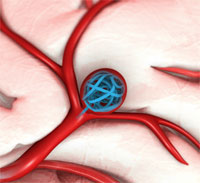 Simple Coil Embolisation |
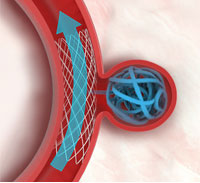 Stent (a flexible metal tube) – Assisted Coiling |
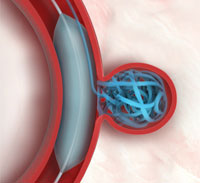 Balloon – Assisted Coiling |
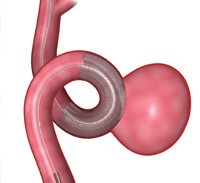 Flow Diverting Stent |
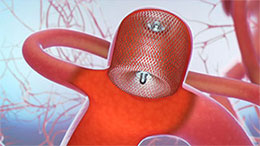 Intrasaccular flow disruptor |
Although endovascular repair effectively treats aneurysms, it is associated with certain risks. However these risks and complications are usually less than those associated with craniotomy and clipping (open surgery), and can be minimised by having your procedure performed by an experienced neurointerventionist. Some of the risks include:
- Blood clots may form inside the coil, catheter, or in the vessels that can break loose and block other arteries, leading to stroke
- Aneurysm may rupture when inserting the catheter, coils, or guidewires
- Narrowing of the artery or vasospasm
- Inadvertent misplacement of the coils – Some coils may extend into the artery and may narrow the parent artery
- Incomplete filling of coils in aneurysm allowing regrowth of aneurysm
Open Surgical Aneurysm Repair
Even though most aneurysms can be treated by endovascular techniques, some aneurysms may be best treated by open repair. A surgeon specializing in surgery on brain blood vessels opens a small hole in the skull, retracts the brain near the aneurysm, and places one or more small clips across the opening to the aneurysm to block it off from the rest of the circulation.
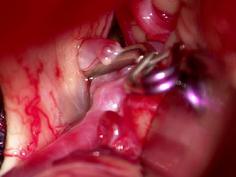 Metal clip after placement across bottom of ruptured aneurysm |
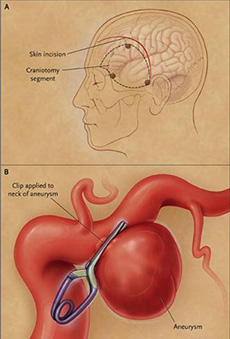 |
Like endovascular repair, open surgery for brain aneurysms must be performed by specially trained surgeons who are experienced in the techniques involved.
The SNIS team work in close collaboration with experienced neurosurgeons specializing in open aneurysm repair. If you would like an opinion regarding open repair for your aneurysm, we are always happy to arrange a referral for you during consultation.
FOR MORE INFORMATION OR TO BOOK AN APPOINTMENT FOR CONSULTATION REGARDING YOUR BRAIN ANEURYSM, CLICK HERE.














